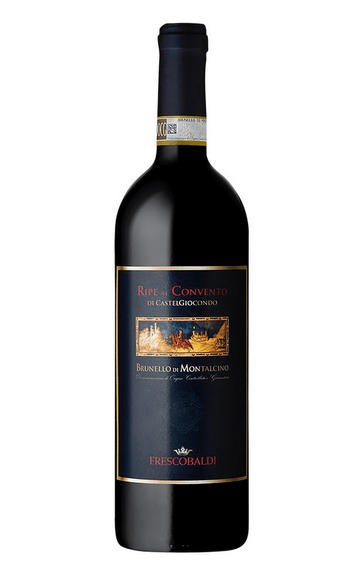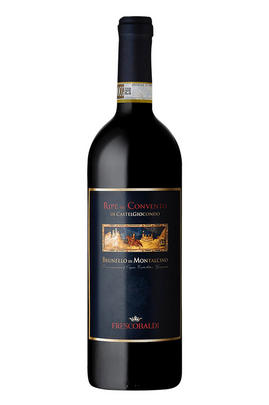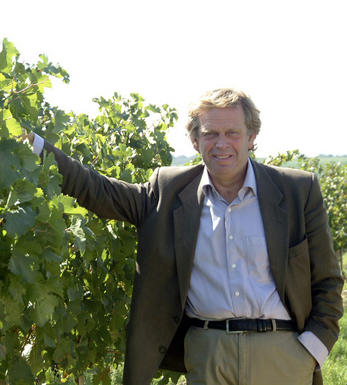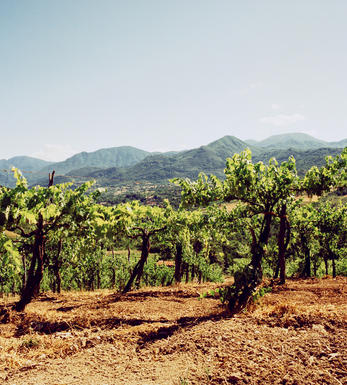
2016 Brunello di Montalcino, Ripe al Convento, Riserva, CastelGiocondo, Frescobaldi, Tuscany, Italy

Critics reviews
The 2016 Brunello di Montalcino Ripe al Convento di Castelgiocondo opens slowly in the glass, with grumblings of exotic spice, red currants, pine and roses that come forward with coaxing. This takes a turn toward total elegance on the palate, which is both silky and weighty in feel, with a core of bright acidity to balance. Cherries, strawberries and hints of plum can all be found, yet a coating of fine-grained tannins builds toward the close and then clenches down hard through the finale. Salted licorice and inner violet tones linger on. It will be many years before 2016 reveals the full depths of its potential.
Drink 2026 - 2036
Eric Guido, Vinous.com (December 2021)
Full of pleasure and power, a masterclass in the herb-fruit-acidity mix that is so much part of Italian wine, just savoury enough to be mouthwatering, sweet enough to be welcoming. There is plenty of power here, with rich raspberry and black cherry fruits, touches of smoked butterscotch and soy, melted tannins and a ton of pepper and spice. Stainless steel fermentation then oak for ageing, for a total of 6 years after harvest before release.
Drink 2024 - 2040
Jane Anson, JaneAnson.com (August 2022)
Lustrous ruby. Tingling, exotic spice and cherry-liqueur nose with a hint of gingerbread. Succulent and dense on the palate and with oodles of juicy acidity. The coating tannins are almost completely absorbed in the lush fruit on the finish.
Drink 2022 - 2030
Walter Speller, JancisRobinson.com (March 2022)
This is a production of 12,000 bottles.
The Frescobaldi 2016 Brunello di Montalcino Riserva Ripe al Convento di CastelGiocondo opens a happy new chapter for this celebrated Tuscan wine family. The Frescobaldis have successfully embraced the classic and iconic qualities of the vintage with the chiseled and sharp aromas that came naturally in 2016. Those etched contours come forth as cherry, blackberry, rose, spice, tar and tobacco. However, the wine's 15% alcohol is a distraction here, as it is in many of the Riservas tasted in this report.
Drink 2024 - 2040
Monica Larner, Wine Advocate (February 2022)
Blackberry, black-cherry, bark, mushroom and lavender aromas. Full-bodied with intense, polished tannins and bright acidity. It’s so long, linear and structured. A powerful and so serious red. Goes on for minutes.
Try after 2025
James Suckling, JamesSuckling.com (November 2021)
About this WINE

Marchesi De Frescobaldi
Marchesi di Frescobaldi, one of the oldest Italian wine companies and the largest, is something of a paradox. The company which owns nearly 1000 hectares of vineyard land in Tuscany remains in the control of one family which, while it traces its history back at least seven centuries, has also consistently been at the forefront of the modernisation of the Italian wine industry. The family has been producing wine since 1300 and produces an exemplary range of wines from its estates at Castello di Nipozzano, Pomino and CastelGiocondo.
Tenuta CastelGiocondo is one of the original Brunello estates, originally an ancient stronghold built in 1100. One of the first four properties to produce Brunello di Montalcino in 1800, it has been owned by Frescobaldi since 1989. Named after an ancient castle and a small medieval village to the south-west of Montalcino, CastelGiocondo hosts an ideal terroir for high-quality Sangiovese.
The 151-hectare estate is home to a unique combination of soils, altitudes and microclimates, which allow the grapes to grow with delicacy, balance and harmony. The soils vary by altitude, with clay at 250 metres; well-drained sandstone at 300 metres; and the high-quality galestro soils at 350-450 metres – where the best Sangiovese for the Brunello and Ripe al Convento are grown. While not officially certified, the estate has been farmed organically since 2013, working with the greatest respect for the terroir and land surrounding them.
The Frescobladis` links with the Mondavi family in California have resulted in the joint purchase of a estate in Montalcino adjacent to Castelgiocondo to produce the company's flagship wine - Luce. The Luce site was selected for its potential to produce the very best fruit and there is no compromise in its winemaking or its viticultural care. It represents the very best that the company can produce. The company also produces the Lucetta, a wine from a blend of the very best parcels of fruit from all the company's Tuscany vineyards. Both wines contain Merlot as well as the traditional Sangiovese.

Brunello di Montalcino
Along with Chianti, Brunello di Montalcino is Tuscany's most famous DOCG and the region's boldest expression of Sangiovese. Located 30 miles south of Siena with the hilltop town of Montalcino as its epicentre, its 2,000 hectares of vines are naturally delimited by the Orcia, Asso and Ombrone valleys. Brunello is the local name for the Sangiovese Grosso clone from which Brunello di Montalcino should be made in purezza (ie 100 percent).
The Brunello di Montalcino DOCG has a whale-like shape: at its head, at 661 metres above sea level on ancient, stony galestro soils facing east and southeast lies the town of Montalcino, where the DOC was founded. As you follow the spine south towards the tail, the vineyards lose altitude – those around Colle Sant'Angelo are at 250 metres – while the soils become richer with iron and clay. Further east, in the shadow of the 1,734 metre Mont'Amiata lies the village of Castelnuovo dell'Abate where the vineyards are strewn with a rich mix of galestro, granitic, volcanic, clay and schist soil types.
Historically, the zone is one of Tuscany's youngest. First praised in 1550 by Leandro Alberti for the quality of its wines, it was Tenuta Il Greppo who bottled the inaugural Brunello di Montalcino in 1888. By 1929, the region had 925 hectares of vines and 1,243 hectares of mixed crops, while in 1932 it was decreed that only those wines made and bottled within the commune could be labelled as Brunello di Montalcino. Since then, the number of producers has risen from 11 in 1960 to 230 in 2006, while over the same period the vineyards have expanded from 1,000 hectares to 12,000. The region earned its DOC in 1966, and was upgraded to DOCG in 1980.
Brunello di Montalcino cannot be released for sale until five years after the harvest, or six years in the case of Brunello di Montalcino Riserva. During this time the wines should be aged for at least two years in oak, followed by at least four months in bottle (six months for Riservas); maximum yields are 55 hl/ha.
Rosso di Montalcino is declassified Brunello di Montalcino, released for sale 18 months after the harvest.
Recommended producers: Costanti, Fuligni, Lisini, San Giuseppe, Soldera, Cerbaiona

Sangiovese
A black grape widely grown in Central Italy and the main component of Chianti and Vino Nobile di Montepulciano as well as being the sole permitted grape for the famed Brunello di Montalcino.
It is a high yielding, late ripening grape that performs best on well-drained calcareous soils on south-facing hillsides. For years it was blighted by poor clonal selection and massive overcropping - however since the 1980s the quality of Sangiovese-based wines has rocketed upwards and they are now some of the most sought after in the world.
It produces wines with pronounced tannins and acidity, though not always with great depth of colour, and its character can vary from farmyard/leather nuances through to essence of red cherries and plums. In the 1960s the advent of Super Tuscans saw bottlings of 100% Sangiovese wines, as well as the introduction of Sangiovese/Cabernet Sauvignon blends, the most famous being Tignanello.


Buying options
Add to wishlist
Description
From CastelGiocondo’s highest vineyard, this has an excellent freshness which perfectly balances the robust, juicy fruits bursting from the wine. Outstandingly complex, red and black plums integrate mouth-wateringly with dark chocolate, coffee and autumn herbs. The tannins are firm but silky, giving an impressive structure for this wine to continue to develop over the next decade or so.
Drink 2025 - 2035
Davy Żyw, Senior Buyer, Berry Bros. & Rudd
wine at a glance
Delivery and quality guarantee